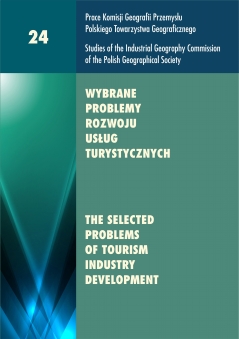Diversification of International Tourism in European Union under Economic Crisis
DOI:
https://doi.org/10.24917/20801653.24.1Keywords:
European Union, international tourism, tourism flows, tourist expensesAbstract
During the economic crisis, there has been a decline in the rate of growth of foreign touristarrivals, both in the world (for example, in 2008-2009 the number of foreign tourist arrivals fell from919 to 880 million) and the European Union (down from 486 to 462 million). The purpose of this articleis to show an impact of world economic crisis on the intensity and spatial variation of internationaltourism to the countries of the European Union at the beginning of the twenty-first century, witha particular focus on the years 2007-2011. The arrivals of foreign tourists to the European Union andits selected countries were shown generatings the most intensive tourism flows, as well as the changesin the structure of these arrivals were discussed. The diversity of international tourism receipts fromselected EU countries during the given period of time was also investigated. Tourism flows are alsoaffected by demographic changes, especially the aging of the population. Therefore the diversity oftourism flows and foreign tourism spending by age was examined.Downloads
References
Butowski, L. (2009). Turystyka w polityce spójności gospodarczej i społecznej Unii Europejskiej, Warszawa: Wydawnictwo Difin.
Dziedzic, T., Łopaciński, K., Saja, A., Szegidewicz, J. (2009). Wpływ światowego kryzysu gospodarczego na stan i perspektywy rozwoju sektora turystyki w Polsce. Warszawa: Departament Turystyki Ministerstwa Sportu i Turystyki.
EUROSTAT (2012a). Tourism in the EU 27. Newsrelease, 99/2012 – 28 June 2012, http://ec.europa. eu/eurostat.
EUROSTAT (2012b). Tourism in Europe: Results for 2011. Statistics in Focus, 28/2012, http://ec.europa.eu/eurostat.
Eurostat Regional Yearbook (2012). EUROSTAT, European Commission.
Gierańczyk, W., Rachwał T. (2012). Structural Changes in the Industry of Poland Against the Background of Eastern European Union States. Quaestiones Geographicae, 31(2), 83–93.
Gotowt-Jeziorska, A., Łopaciński, K. (red.) (2011). Turystyka w Polsce w okresie kryzysu. Warszawa: Polskie Stowarzyszenie Turystyki.
King, R., Patterson, G. (1998). Diverse Paths: the Elderly British in Tuscany. International Journal of Population Geography, 4, 157–182.
Komisja Europejska (2010). Europa – najpopularniejszy kierunek turystyczny na świecie – nowe ramy polityczne dla europejskiego sektora turystycznego. Komunikat Komisji do Parlamentu Europejskiego, Rady, Europejskiego Komitetu Ekonomiczno-Społecznego i Komitetu Regionów, Bruksela, KOM (2010), 352.
Kruczek, Z. (2008). Europa. Geografia turystyczna, Kraków: Wydawnictwo Proksenia.
Mantecón, A. (2010). Tourist Modernisation and Social Legitimation in Spain. International Journal of Tourism Research, 12, 617–626.
Mika, M., Faracik, R. (2008). Międzynarodowy ruch turystyczny. W: W. Kurek (red.). Turystyka, Warszawa: PWN, 66–120.
Nosek, A., Pietrzak, A. (2009). Efekt domina czyli międzynarodowa transmisja kryzysów – na przykładzie współczesnego kryzysu finansowego. W: W. Michalczyk (red.). Wybrane problemy gospodarki światowej pierwszej dekady nowego wieku, Wrocław: Uniwersytet Ekonomiczny we Wrocławiu, 82–92.
Pawlicz, A. (2011). Turystyka międzynarodowa. W: P. Panasiuk (red.). Ekonomika turystyki, Warszawa: PWN, 182–199.
Rodríguez, V., Fernández-Mayoralas, G., Rojo, F. (1998). European Retirees on the Costa del Sol: a Cross-national Comparison. International Journal of Population Geography, 4, 183–200.
Sedgley, D., Pritchard, A., Morgan, N. (2011). Tourism and Ageing. A Transformative Research Agenda. Annals of Tourism Research, 38 (2), 422–436.
UNWTO World Tourism Barometer (2010), 8(1), www.unwto.org/facts/eng/pdf/barometer/UNWTO_ Barom10_1_en.pdf.
Warnes, A.M., Patterson, G. (1998). British Retirees in Malta: Components of the Cross-national Relationship. International Journal of Population Geography, 4, 113–133.
Williams, A.M., Patterson, G. (1998), An Empire Lost but a Province Gained’: a Cohort Analysis of British International Retirement in the Algarve. International Journal of Population Geography, 4, 135–155.
Zdon-Korzeniowska, M., Rachwał, T. (2011). Turystyka w warunkach światowego kryzysu. Prace Komisji Geografii Przemysłu Polskiego Towarzystwa Geograficznego, 18, 116–128.
Downloads
Published
How to Cite
Issue
Section
License
Articles are published under the terms of the Creative Commons License (CC BY-ND 4.0; Attribution– NoDerivs).

